
- This event has passed.
Colorado Aspen Summit
August 9, 2022 - August 11, 2022
Summary of Event and Photos
 Field visit to aspen stand in Rocky Mountain National Park. Photo credit: Gloria Edwards
Field visit to aspen stand in Rocky Mountain National Park. Photo credit: Gloria Edwards
Purpose
This field-based workshop united scientists, vegetation and wildlife managers bridging disciplines, institutions, and political boundaries to address aspen management challenges in northwest Colorado. The group examined Process-Based Restoration (PBR), a term borrowed from those working to initiate specific processes and mimic function in river ecosystems, and its applicability to aspen management. By visiting different types of properties – federal, state and private – participants gained a first-hand understanding of disturbance interactions and their implications for aspen management.
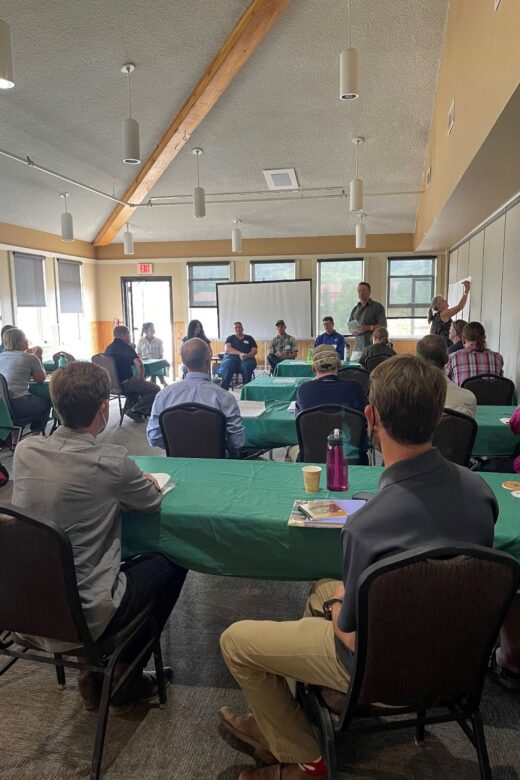
Paul Rogers of the Western Aspen Alliance moderates a panel discussion at the end of the first day of the Aspen Science, while Gloria Edwards captures ideas on resources and needs. Photo credit: Brooke Simmons
Presentations
The summit kicked off with speakers exploring key processes, ecosystem disrupters, and restoration in aspen. Following a general overview by Paul Rogers of the Western Aspen Alliance, speakers used case studies to address herbivory and trampling, climate disturbances such as beetle outbreak and wildfire, and highlighted unique management challenges on federal, state and private land. We ended the August 9th session with a group discussion about research gaps and an exploration of where we are going collectively. Some of the key themes discussed are how to get science to managers, the need to generate up-to-date knowledge about aspen management, and the need to evaluate processes through the monitoring and the adaptive management process.
You can review each presentation at the hyperlinks below:
Aspen Ecology & Science, Paul Rogers, Utah State University
Fire, Climate and Multiple Disturbances, Sarah Hart, Colorado State University
Mountain Pine Beetle and Aspen, Kristen Pelz, Rocky Mountain Research Station
Elk and Aspen Management at RMNP, Hanem Abouelezz, Bureau of Land Management
Aspen and Habitat Management, Casey Cooley, Colorado Parks and Wildlife
Aspen Management and Silviculture, Shelby Limberis, White River National Forest
Aspen Management on Private Land, Zach Wehr, Colorado State Forest Service
Many thanks to all our presenters for sharing your insights, challenges, and real-time solutions.
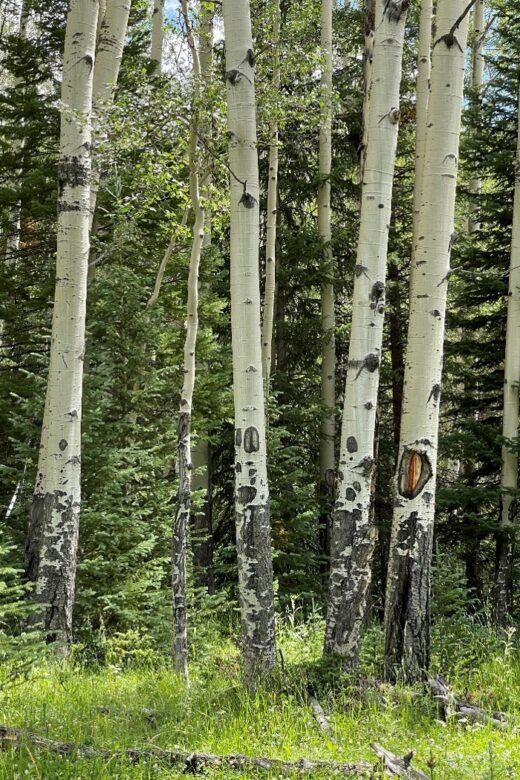
Aspen stand with evidence of past heavy browse at Timber Lake trailhead in Rocky Mountain National Park.
Photo credit: Brooke Simmons
Attendees
Approximately, 35 people participated in the three-day summit, including representatives from National Park Service, The Nature Conservancy, American Forests, Western Aspen Alliance/Utah State University, Southern Rockies Fire Science Network, US Forest Service, Colorado Forest Restoration Institute, Colorado State Forest Service, researchers at local universities including University of Northern Colorado, University of Colorado and Colorado State University, city and county open space managers, non-profits and citizens.

Field trip at Rocky Mountain National Park East Inlet Trailhead with Scott Esser, director of the Continental Divide Research Learning Center (front-left in park uniform), discussing aspen, herbivory and historical wildfire. Photo credit: Gloria Edwards
Field-based learning
Over the next 2 days, the group visited federal, state and private land to learn about aspen management challenges and opportunities, recognizing the unique goals at each location.
On the morning of August 10th, Scott Esser, Director of the Continental Divide Research Learning Center, Nate Williamson, Fire Ecologist, and Koren Nydick, Resource Stewardship Manager, welcomed us to Rocky Mountain National Park.
The East Inlet Trail to Adams Falls is a .3mi one way hike that has aspen littering both sides of the trail. This site has lots of regeneration however does show some sign of herbivory, one of the main drivers of the lack of aspen regeneration success. This site last burned in 1851 based on fire history research from the early 2000s. Additionally, there was a small blow down event in this area that created a more recent disturbance which is likely what produced a lot of the regeneration we see in the area. This provided a discussion around compounding disturbance or disturbance interactions.

Group discussion in the East Inlet trailhead parking lot. Photo credit: Brooke Simmons
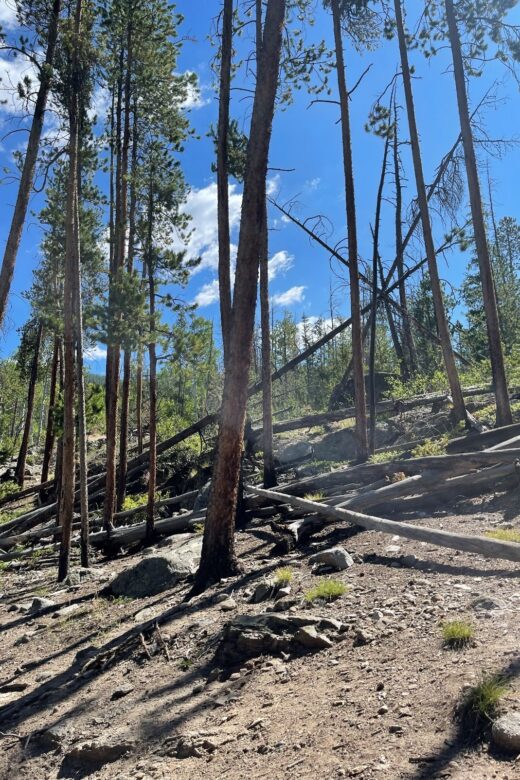
Dead and down aspen on the East Inlet trail. Photo credit: Brooke Simmons
After visiting aspen stands at East Inlet, the group headed into the west-side of the Park to Timber Lake, an area with older aspen encroached by spruce and fir.
The Timberlake trailhead is about a 25 minute drive north from East Inlet through the Grand Lake Entrance. This site consists of a mixed conifer/aspen forest. There is quite a bit of successional evidence here as larger diameter aspen take up a large proportion of the canopy with smaller shade tolerant conifers starting to make their move into the canopy. This site however has nearly no aspen regeneration and the few aspen seedlings/saplings seen on the edges of the canopy gaps had signs of herbivory on them. Directly across the road from this site is an elk/moose exclosure from an experiment in the 1990s. While this exclosure is protecting willow from herbivory, similar exclosures are currently installed on the east side of the park to protect aspen under the Elk and Vegetation Management Plan that Hanem Abouelezz presented on. This site provided an opportunity to see a seral aspen stand exhibiting signs of aspen senescence and herbivory within the park along with the pronounced effects of herbivory exclusion in regenerating sprouting species.
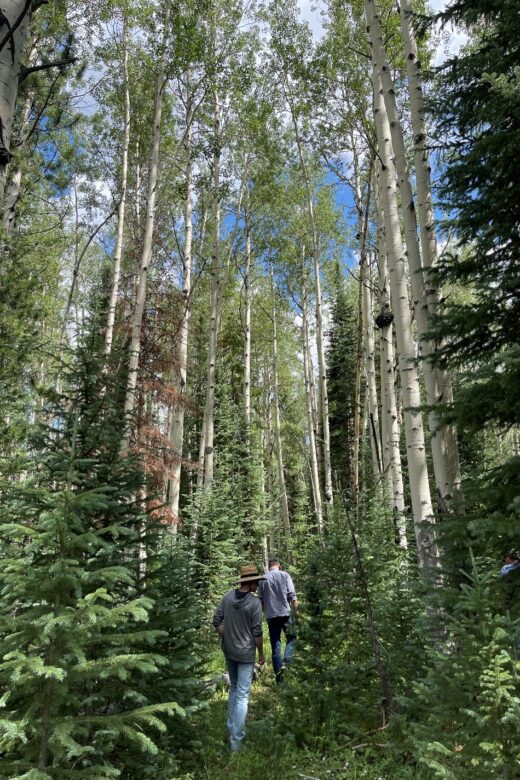
Participants explore an aspen stand near Timberlake trailhead. Photo credit: Brooke Simmons
That afternoon, the group traveled from Rocky Mountain National Park to the C Lazy U Ranch, an ~8,500 acre luxury dude ranch, just outside of Granby. There, owner Don Bailey and ranch hands Corey Chase and Jared met the group and shared the ranch history and emerging post-fire management challenges.
The ranch includes 5,500 working acres including pastures for the 200 horses, and a small herd of cattle. The remaining acres are under a conservation easement held by The Nature Conservancy and this designation ensures that those areas will remain undeveloped. Close to ~80% of the ranch burned in the 2020 East Troublesome fire, which included the loss of 4 buildings. Thankfully all the staff and stock animals safely evacuated before the fires crossed onto the ranch.

Attendees discuss fire effects and management options at the C Lazy U Ranch. Photo credit: Brooke Simmons
Following the 2020 East Troublesome fire and in the midst of the global COVID pandemic, the ranch owners developed a financial sustainability plan for the ranch, titled, “Vision 100”, a long-term look at how to make the ranch financially sustainable over its next 100 years of operation. This included a look at guest services, surrounding development pressures, and post-fire recovery. This holistic analysis allowed for owners to make critical decisions about future investment in rebuilding and also included the decision to place 500 additional acres under easement.
The group visited a burned aspen stand with shoulder-high sprouts just two-years after the fire. We hypothesized that the aspen might have been part of a stable stand (as opposed to a “seral” stand) given that we did not observe any conifer encroachment in the stand. The regeneration showed little browse, unlike what we saw at Rocky Mountain National Park. We hypothesize that the lower browse pressure may relate to hunting, which is allowed on the ranch. Managers had removed dead and down from the trails, but otherwise left everything standing.
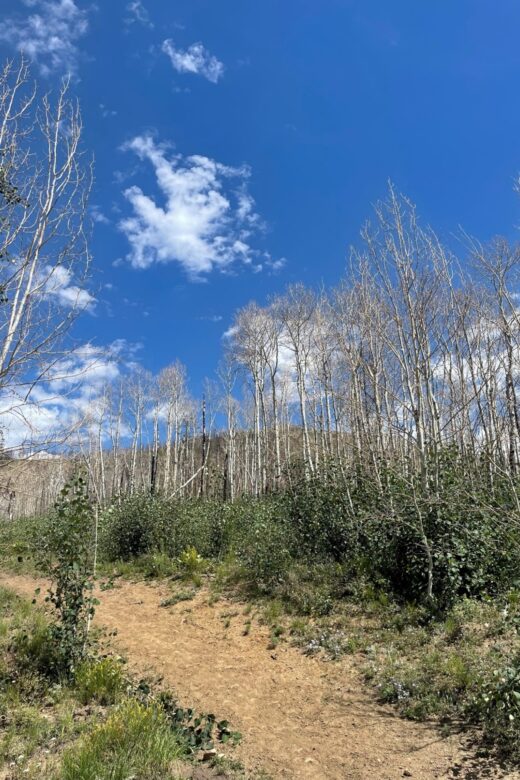
Aspen stand burned by the 2020 East Troublesome fire is recovering vigorously on the C Lazy U Ranch. Photo credit: Brooke Simmons
Post-fire the ranch has several unique challenges. Burned aspen sprouts, each 6-12 inches tall and with a sharp point, are found throughout the pasture area and have been causing puncture wounds in the horse herd. The ranch has tried removal by hand with pruners and even rented a large masticator to chopper-roll the pastures and remove the burned sprouts, but neither technique has been viable at the scale of the ranch. The group had never seen or heard about burned aspen sprouts and couldn’t provide any advice, other than that already employed by ranch staff.

Photo of the burned aspen sprouts. Photo credit: Yan Chun Su
The ranch also mentioned prolific aspen regrowth on trails and the high cost of maintaining the trails open and aspen-free. The group concurred that aspen often responds vigorously to disturbance, like trail clearing, and would likely continue to be a management challenge. In a few side conversations, some suggested re-routing trails away from aspen to reduce costs of trail maintenance.
Some of the observations from the group included:
- Questions about use of the ranch for and by birders, as the fire creates a bunch of novel early-successional ecosystems with diverse bird habitat and species. This was flagged as an opportunity for ranch managers to explore.
- Questions about how the ranch messaged the fire and its recovery to guests and a long discussion about the immediate message and storytelling, as well as a shorter discussion of how to talk about ecosystem change over time as part of a long-term natural process. This was a follow-up to some of the conversation at Rocky Mountain National Park, where they had thought carefully about the message to visitors and how to better train rangers and volunteers to tell the ecological story of change over time (instead of damage and loss), and not only the more anthropogenic story of human loss.
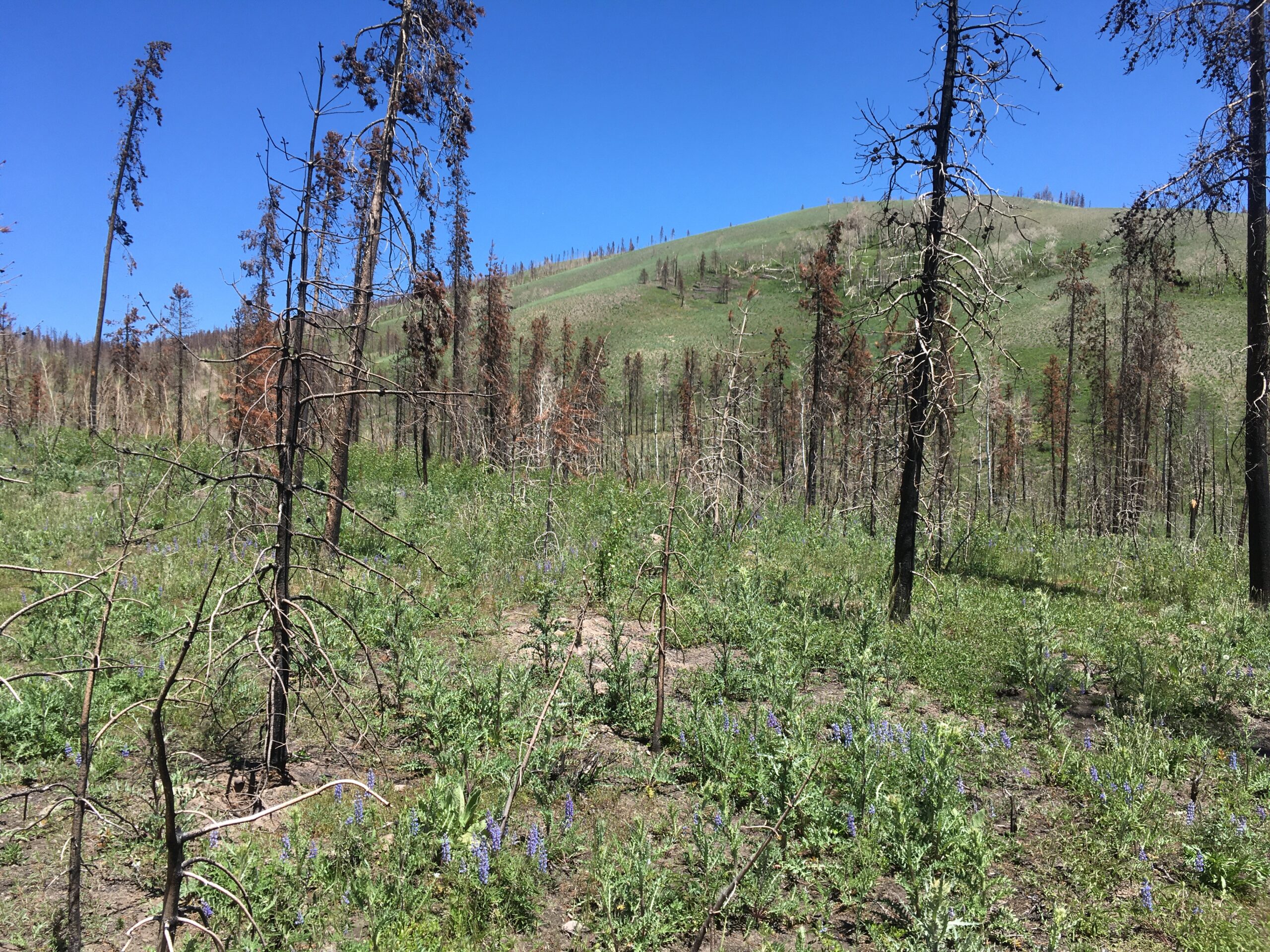
Photo of C Lazy U Ranch aspen regeneration. Photo credit: Catherine Schloegel
To end the day and in response to the evolving conversation about the effects of fire in the upper montane forest systems, Brad Piehl led an impromptu visit to a large debris flow at Willow Creek, 5 minutes north of the ranch entrance. There, a small watershed burned at high severity has a major debris flow into the Willow Creek River. The group discussed the significant impacts of fire on water resources, providing a more nuanced response to the general discussion about wildfire and its impacts. While some forest types are particularly resilient to fire, like aspen, the impacts of wildfire are multi-faceted across an entire system.
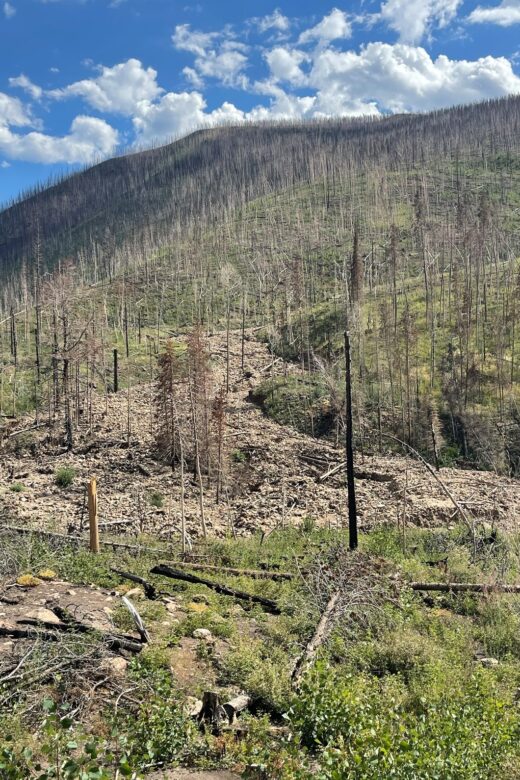
Debris flow in the Willow Creek drainage west of Highway 125 in the East Troublesome fire burn area. Photo credit: Brooke Simmons
On August 11th, the group visited Carter Mountain, a State Land Board trust property just south of Kremmling, with the Colorado State Forest Service’s Northwest Area Manager, Ron Cousineau, local Colorado State forester, Matt Shultz, and private forester, John Trieber. Parts of the area had been coppice-clearcut in the 1990s and supplied to a local mill, the Louisiana Pacific waferboard plant in Kremmling where John Trieber worked. The mill operated for 8 years before relocating out of state.
Local managers expressed concern about a lack of aspen regeneration in some stands. The group visited the stands, exploring how the management in a stable stand, like those at Carter Mountain, is different from the prescriptions for a seral stand. The group observed some parts of the stand that were not regenerating at all after the 1990-era harvest, and other portions of stands had recovered and formed a very dense, even-aged recovery. Other stable stands, including the well-known Pando Clone in Utah, have had a similar post-harvest response, e.g. unable to recover likely due to browse pressure. In reflecting on the adaptive management cycle, it begins with understanding system type, as an input to selecting the most suitable management tools.
Paul Rogers shared that stable stands are often composed of multi-aged individuals with young and old trees present. When you encounter an even-aged stable aspen stand, it is good to look at the factors impacting sprouting. In this case, we observed cattle grazing, which may trample new sprouts. There could also be high browse pressure from elk or moose. We made a key distinction that cattle trample, while elk browse aspen, as there had been some previous confusion about the source of browse.
The conversation ended with a discussion highlighting the importance of monitoring and adaptive management over time.
Special Thanks
Special thanks to Locke + Co, for attending the summit and providing education on private aspen management and the distilling process (and whiskey sampling) to attendees. Locke + Co uses charred aspen rings produced from their private ranch near Fairplay, CO in their distillation process.
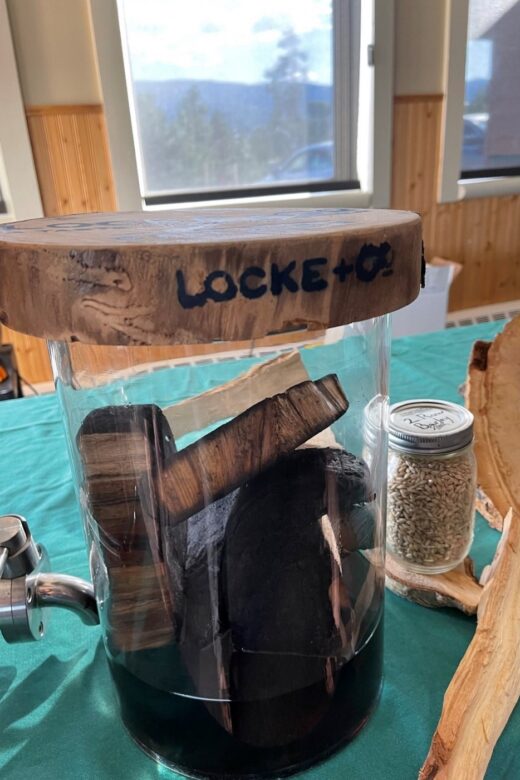
Charred aspen disks used in finishing the flavor of the Locke + Co aspen rye. Photo credit: Gloria Edwards
Special thanks to our sponsors: Western Aspen Alliance, The Nature Conservancy in Colorado, American Forests, Southern Rockies Fire Science Network, Colorado State Forest Service, Forest Service- Rocky Mountain Region, National Park Service – Rocky Mountain National Park, and National Park Service – Continental Divide Research Learning Center.

Happy participants of the Locke + Co aspen rye tasting event. Photo credit: Brooke Simmons
Next steps (discussion from the last day)
- There is a need for continued sharing between scientist and managers
- What sorts of info are we talking about sharing?
- From the scientists: Evolving knowledge about aspen management, especially new information that runs counter to decades-old data and management techniques.
- From the managers: field observations and associated prescriptions, reflections on monitoring and what is being learned
- How?
- Field trips/tours with managers and scientists. Annual Western Aspen Alliance conference highly encouraged.
- Western Aspen Alliance fact sheets – short summaries of key issues such as oystershell scale
- YouTube short videos, ~ 5 minutes
- Monitoring aspen stands matters!
- Citizen science: Rapid Aspen Regeneration Assessment (RARA) program at Rocky Mountain National Park is one model that uses citizen scientists to monitor stand condition. Training citizen scientists requires an investment, but in this case, it is working well.
- Regional trends: There is no large-scale experimental design across sites and there is interest in using individual monitoring to contribute to regional knowledge, but no consensus on who would lead such an effort.
- We imagine developing a body of evidence about unique prescriptions or treatments for North versus South-facing slopes, for example.
- Browse: let’s be more specific on the effects of browse by domestic and wild animals and how it is affecting aspen.
- Compounding disturbances: How is aspen fairing post wildfire in areas with high browse?
- Build resilience into management: recognize aspen systems including distinctive seral and stable aspen types and manage accordingly. Use the adaptive management cycle (with monitoring) to incorporate new assumptions and approaches.
- What sorts of info are we talking about sharing?
